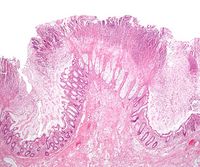Difference between revisions of "Clostridium difficile"
| (5 intermediate revisions by the same user not shown) | |||
| Line 1: | Line 1: | ||
| − | {{ | + | {{OpenPagesTop}} |
| − | |||
[[Image:Clostridium difficile.jpg|200px|thumb|right|'''Clostridium difficile''' (Author: Nephron, Wikimedia Commons)]] | [[Image:Clostridium difficile.jpg|200px|thumb|right|'''Clostridium difficile''' (Author: Nephron, Wikimedia Commons)]] | ||
| Line 9: | Line 8: | ||
It is a motile bacteria, showing optimal growth on blood agar. | It is a motile bacteria, showing optimal growth on blood agar. | ||
| + | {{Learning | ||
| + | |literature search = [http://www.cabdirect.org/search.html?start=0&q=%28%28ab%3A%28meat%29%29%29+AND+%28%28title%3A%28%22Clostridium+difficile%22%29%29%29 ''Clostridium difficile'' in meat publications] | ||
| + | |||
| + | [http://www.cabdirect.org/search.html?q=%28%28od%3A%28dogs%29%29%29+AND+%28%28title%3A%28%22Clostridium+difficile%22%29%29%29 ''C. difficile'' in dogs publications] | ||
| + | |||
| + | [http://www.cabdirect.org/search.html?q=%28%28od%3A%28cats%29%29%29+AND+%28%28title%3A%28%22Clostridium+difficile%22%29%29%29 ''C. difficile'' in cats publications] | ||
| + | |||
| + | [http://www.cabdirect.org/search.html?q=%28%28od%3A%28horses%29%29%29+AND+%28%28title%3A%28%22Clostridium+difficile%22%29%29%29 ''C. difficile'' in horses publications] | ||
| + | |||
| + | [http://www.cabdirect.org/search.html?q=%28%28od%3A%28sheep%29%29+OR+%28od%3A%28cattle%29%29+OR+%28od%3A%28goats%29%29+OR+%28od%3A%28pigs%29%29%29+AND+%28%28title%3A%28%22Clostridium+difficile%22%29%29%29 ''C. difficile'' in farm animals publications] | ||
| + | }} | ||
| + | |||
| + | {{OpenPages}} | ||
| + | [[Category:Clostridium_species]][[Category:Dog Bacteria]][[Category:Horse Bacteria]] | ||
| − | [[Category: | + | [[Category:Expert_Review]] |
| − | |||
| − | |||
Latest revision as of 17:52, 5 July 2012
Clostridium difficle is a gram positive bacteria of the family Clostridiaceae. They are part of the normal flora, so known as a commensal bacteria. The problem arises when the bacteria competing within the host are destroyed by antibiotics.
C. difficle become overpopulated, and begin to produce pathogenic strains producing toxins, namely enterotoxin and cytotoxin. These may cause diarrhoea, and abdominal pains, or pseudomembranous colitis (PMC) under more severe circumstances.
It is a motile bacteria, showing optimal growth on blood agar.
| Clostridium difficile Learning Resources | |
|---|---|
 Search for recent publications via CAB Abstract (CABI log in required) |
Clostridium difficile in meat publications
C. difficile in dogs publications C. difficile in cats publications |
Error in widget FBRecommend: unable to write file /var/www/wikivet.net/extensions/Widgets/compiled_templates/wrt694227b981b0e3_72329987 Error in widget google+: unable to write file /var/www/wikivet.net/extensions/Widgets/compiled_templates/wrt694227b98b8559_92933542 Error in widget TwitterTweet: unable to write file /var/www/wikivet.net/extensions/Widgets/compiled_templates/wrt694227b99d60b5_77048696
|
| WikiVet® Introduction - Help WikiVet - Report a Problem |
